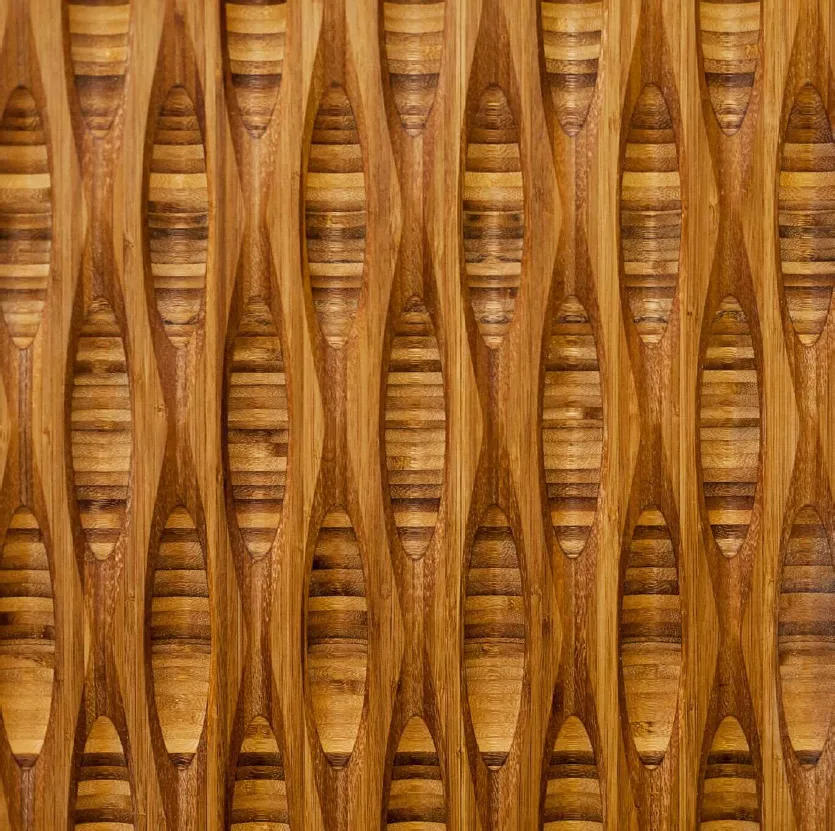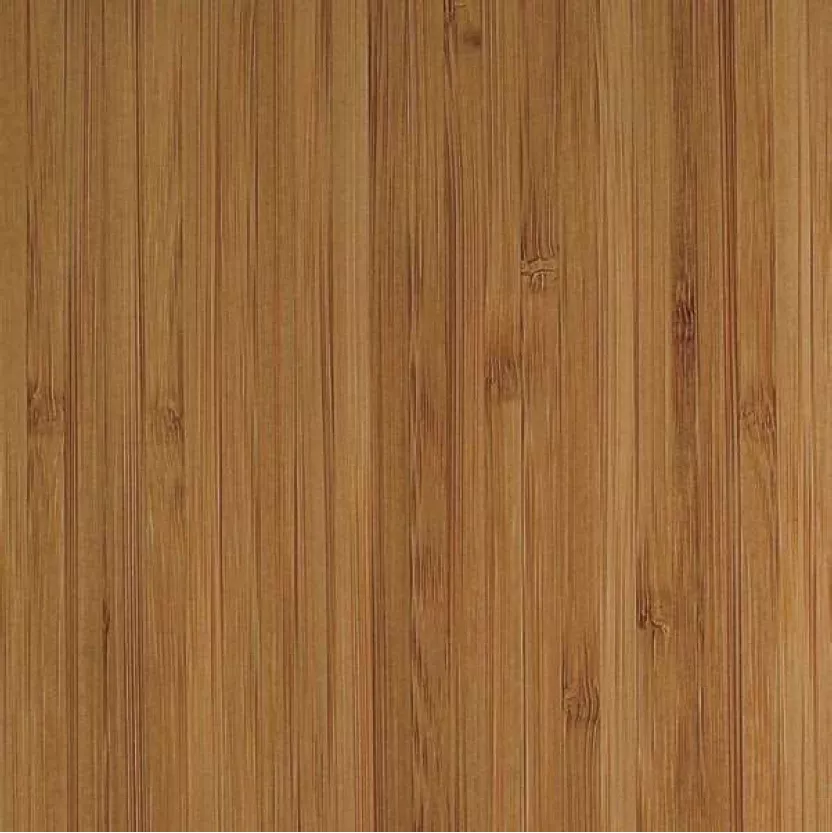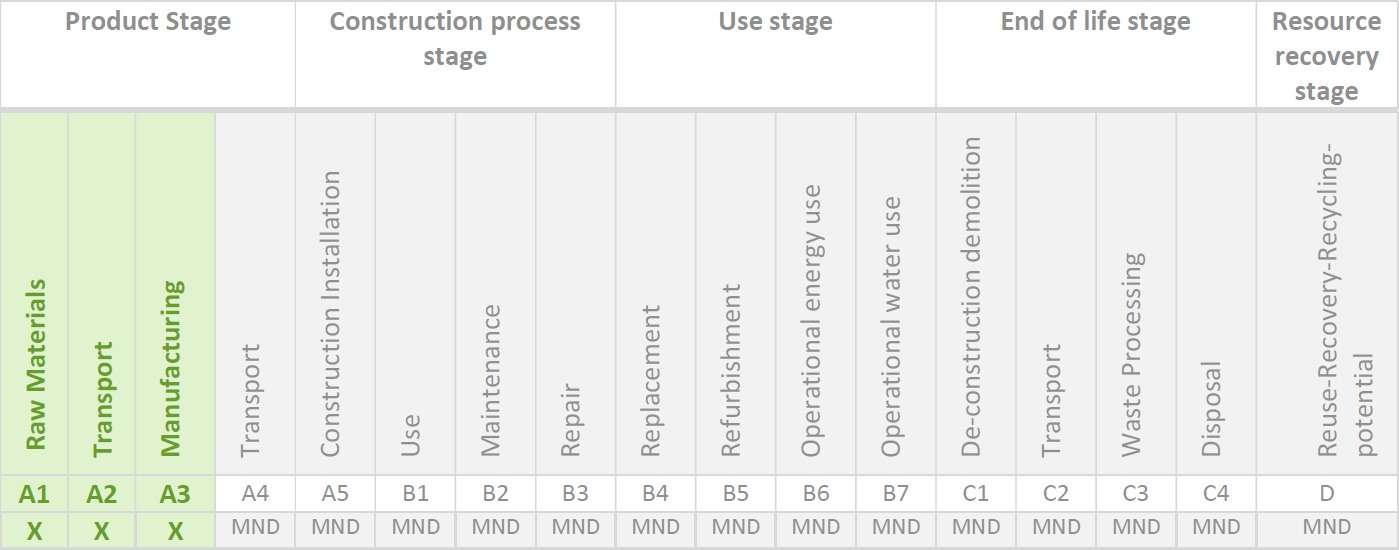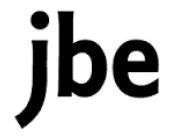Life Cycle Analysis/EPD
Life Cycle Analysis/EPD

Environmental Product Declaration
In accordance with ISO 14025 for:
Flat and Edge Grain Plyboo
Smith & Fong
475 Sixth Street San Francisco, CA 94103
| Programme: | ASTM International https://www.astm.org/ |
| Programme operator: | ASTM International |
| EPD registration number: | EPD 072 |
| Approval date: 2017-10-18 | Valid until: 2022-10-18 (5 years) – extended until 2023-08-18 |
| Revision date: – | Geographical scope: Global |



Product
Product Description
Plyboo® bamboo plywood (flat and edge grain) is a panel product made entirely from Moso bamboo. All panels are of a 3-ply construction having a face skin on top and bottom with a perpendicular core. On a typical ¾ (19mm) panel the face skins are approximately 3.5mm each and the core is 12mm.
This construction is unique to bamboo plywood and is not found in any other wood panel product. The basic building block of the panel is a bamboo strip that measures approximately 0.6mm in thickness with a width of 22mm and a length of 2438mm for the plywood face skin and 1220mm for the plywood core. These strips are laminated together (using an adhesive), sliced and sanded to dimension for their specific application as face skin or core board. Using different lamination orientations, the core board and face skins are produced. There are two lamination methods that produce two different looks for the face skin. With the edge grain lamination, thin narrow laminations are used and for the flat grain, wider strip laminations are used. Ultra-low emitting adhesives (ULEF) are used in the assembly process and once trimmed to dimension and final sanded the boards are packaged and ready for shipment.
Plyboo flat and edge grain bamboo products are available manufactured to the California Air Resource Board (CARB) Phase II Airborne Toxic Control Measure (ATCM) 93120 regulation and the Forest Stewardship Council (FSC®) 100% label requirements. The applicable CPC Code is UN CPC 3145 – Plywood, veneer panels and similar laminated wood of bamboo.
Application
Plyboo bamboo plywood panels can be used in a wide range of applications both commercial and residential. Applications include cabinetry and casework, furniture, store fixtures and displays, wall and ceiling panel systems, doors and many other applications where plywood is typically utilized. Plyboo bamboo plywood can be worked similarly to a traditional wood plywood using the same fabrication techniques and tools including Computer Numerical Control (CNC) carving and cutting equipment. Screws, pin-nails or adhesives can be used to fasten the material together. Standard wood finishes such as poly-urethane, conversion varnishes or traditional oil or wax products have also been used. Plyboo bamboo plywood is both sturdy and versatile and designed for utility as well as aesthetics.
Standard Sizes and Weights
| Product Name | Size Options | Product Weights per Piece |
| Flat Grain Bamboo | 1″ x 48″ x 96″ (25mm x 1219mm x 2438mm) 3/4″ x 48″ x 96″ (19mm x 1219mm x 2438mm) 1/2″ x 48″ x 96″ (12mm x 1219mm x 2438mm) 1/4″ x 48″ x 96″ (6mm x 1219mm x 2438mm) | 110 lbs (50 kg) 90 lbs (41 kg) 65 lbs (29 kg) 35 lbs (16 kg) |
| Edge Grain Bamboo | 1 1/2″ x 30″ x 120″ (38mm x 762mm x 3048mm) 3/4″ x 30″ x 120″ (19mm x 762mm x 3048mm) 3/4″ x 48″ x 96″ (19mm x 1219mm x 2438mm) 1/2″ x 48″ x 96″ (12mm x 1219mm x 2438mm) 1/4″ x 48″ x 96″ (6mm x 1219mm x 2438mm) | 160 lbs (73 kg) 80 lbs (36 kg) 90 lbs (41 kg) (55-80 lbs (25-36 kg) carved) 65 lbs (29 kg) 35 lbs (16 kg) |
Material Content
Material Content for Uncarved and Carved Plyboo
| Material | Uncarved Plyboo Mass % | Carved Plyboo Mass % |
| Bamboo | 98% | 96% |
| Adhesive | 2% | 2% |
| Finishing Compound | Not present | 2% |
Content Declaration
The product contains no substances of very high concern (SVHC) as listed in the “Candidate List of Substances of Very High Concern for Authorisation of the European Chemicals Agency”.
While a urea formaldehyde polymer is used during the manufacturing process, the formaldehyde EC No. 200-001-8 listed on the Material Safety Data Sheet (MSDS) for this material (Prefere 4410) is not included on the SVHC list. The only formaldehyde containing material included on the SVHC list is Formaldehyde, oligomeric reaction products with aniline, European Community (EC) No. 500-036-1.
Scope and Boundaries of the Life Cycle Assessment
The Life Cycle Assessment (LCA) was performed according to ISO 14040 and ISO 14044 and Product Category Rules (PCR) for Construction Products and Services. This report is intended to fulfil the requirements in Section 9 of the PCR. Additional details can be found in the Plyboo LCA report, which documents in greater detail the study goal and scope, inventory analysis, results and interpretation.
Please note: The thousands separator and decimal mark used throughout the EPD and LCA report use SI style (English version), with a comma representing the thousand separator and a period representing the decimal mark.
Declared Unit
The declared unit aims at providing a reference to which the data inputs and outputs are normalized in such a way that the same level of service is represented. The declared unit for this study is 1 kilogram (kg) of final bamboo product (plyboo). The bamboo product assessed in this study is flat and edge grain Plyboo used for various interior applications.
| Name | Value | Unit |
| Declared Unit | 1.00 | kg Plyboo product |
| Density | 690 | kg/m3 |
System Boundary
This Environmental Product Declaration (EPD) is made for “Cradle to Gate” according to EN 15804 and includes stages A1 through A3 (raw materials, transportation, and manufacturing) of Module A (Production and Construction Stages). Figure 1 presents the system boundaries.
Figure 1. LCA System Boundary Diagrams


LCA Modules
The data presented in this EPD refer to the declared modules and form the basis for further calculations. All provided values are based on the declared product unit.
The European norm EN 15804 is based on four distinct modules relating to the lifecycle phases of a building material including the following:
- Module A: Production and Construction Stages
- Module B: Use Stage
- Module C: End of Life Stage; and
- Module D: Environmental Effects Outside of the System Boundary.
Figure 2 presents the stages within each module. This study is a ‘cradle to gate’ assessment, according to EN 15804, which includes stages A1 through A3 of Module A (shown highlighted in green on the table below). The information provided in this EPD is aggregated for modules A1 through A3.
The products reference service life (RSL) is not specified because the study is ’cradle to gate’ and also because there is a wide range of applications for flat and edge grain Plyboo products. Thus downstream life cycle stages are not included since they would be difficult to quantify given the wide range of product applications and uses.
Figure 2. Division of the modules over the lifecycle of a building material as determined in EN 15804.

Key Assumptions
Production operations are identical for all Plyboo products, and the only differences amongst the final products are the final step in the assembly plant during the final cutting and carving step, which generates a variety of dimensions and product weights. There are no significant differences in the energy requirements to carve flat or edge grain bamboo. Additionally, the granularity of the primary production data does not allow for distinguishing amongst the energy requirements for different product sizes/weights as all inputs and outputs are allocated to account for production of all flat and edge grain plyboo products, rather than being allocated to individual product dimensions and affiliated weights.
However, the environmental impacts of each product can be distinguished via their product weights, which vary. This study’s declared unit is 1 kg of finished product (as described below), and therefore each individual product will have unique environmental impacts due to varying weights.
Availability of records varied based on recordkeeping nuances in the manufacturing country. Where records were unavailable, data was estimated based on operational knowledge, engineering judgement, or data available for similar products. This impacted electricity, water, and steam use. Records of quantity (mass) of raw (wet) bamboo grown for milling Faceboard and Coreboard were estimated based on records of face and core board produced and bamboo waste resulting from the milling process and a ratio (0.42) of raw bamboo to dry bamboo in the end product (obtained from a similar product).
The energy content of dry bamboo was estimated to be 19.2 MJ/kg dry bamboo used for steam production from waste bamboo incineration. The carbon content of bamboo used in this study is 0.5 kg C per 1 kg of bamboo.
Cut-off Criteria
The PCR for construction products and construction services specifies that “the Life Cycle Inventory data for a minimum of 95% of total inflows (mass and energy) to the upstream and core module shall be included.” Therefore, in this study, aggregate mass flows that contribute less than 5% of inputs to a life cycle stage may be omitted from the product systems. However, care has been taken when excluding processes from the inventory and wherever data was available, it was included in the study, even if aggregate mass flows for a specific input or output fell below the 5% materiality threshold. This only inflows not included in the LCI model were as follows:
- Milling bits in faceboard milling
- Sandpaper, sawblades and milling tools in assembly
- Diamond bits in carving
The total weight of sandpaper used was estimated and it was determined that the amount used fell below the 5% materiality threshold. The milling bits, sawblades, milling tools, and diamond bits used across the manufacturing operations are sharpened or refurbished, and reused for many years, as part of regular equipment maintenance procedures. Therefore the impacts from these processes are considered immaterial and not included in the inventory flows.
Allocation
Mass allocation was necessary for sawdust by-products at the Coreboard, Faceboard, and Assembly plants in China. The sawdust by-products are sold on the local market and mass allocation was used for these by-products
Geographical Considerations
This product is made following the production protocols of S&F in the factories in China and the United States, which is representative for all S&F flat and edge grain plyboo sold worldwide. S&F flat and edge grain Plyboo is made from giant bamboo sourced from sustainably managed production forests in Zhejiang province, China. The final manufacturing processes are conducted in Hengfan (coreboard milling and assembly) and Juji, Shaoxing (faceboard milling). Approximately ten percent of the Plyboo is sent to Indio, California (CA) for carving and further finishing.
Data Quality
The data used in this LCA were based on S&F process operations and the documentation presented in the International Network for Bamboo & Rattan (INBAR) Technical Report No. 35: The Environmental Impact of Industrial Bamboo Products: Life-cycle Assessment and Carbon Sequestration by P. van der Lugt and J. Vogtlander of Delft University of Technology. Missing data was estimated using the ecoinvent database (v3.3).
Electricity
At the Indio, CA facility (carved plyboo), electricity accounts for more than 30% of the total energy in stages A1 to A3. Electricity accounts for 50% of the total energy in stages A1 to A3 for carved plyboo (including energy from manufacturing in China), and 10% of the total energy in stages A1 to A3 for uncarved plyboo. The total energy sources behind the electricity grid including manufacturing in China and carving in Indio, CA result in 393.3 g CO2e/MJ.
| Product | Electricity Grid Energy Source Contribution (g CO2e/MJ) |
| Uncarved Plyboo, China | 255.7 |
| Carved Plyboo, US | 137.6 |
| Total | 393.3 |
Comparability
A comparison or evaluation of EPD data is only possible if all datasets are made following EN 15804 applying the same relevant product category rules and for the same modules. EPD of construction products may not be comparable if they do not comply with EN15804. Environmental product declarations within the same product category from different programs may not be comparable.
Potential Environmental Impacts
The results presented below are for the listed environmental categories for 1 kg of plyboo bamboo product and are aggregated for Stages A1 through A3. The results are presented for both the carved and uncarved Plyboo.
LCA Results for uncarved and carved Plyboo.
| Environmental Impact |
A1-A3 | |||||||
| (Uncarved Plyboo, China) | (Carved Plyboo, USA) | |||||||
| TRACI | Units | CML (baseline) | Units | TRACI | Units | CML (baseline) | Units | |
| Global warming (fossil and biogenic combustion) | 3.6 | kg CO2 eq |
3.6 | kg CO2 eq. |
7.8 | kg CO2 eq |
7.5 | kg CO2 eq. |
| Biogenic carbon (from biomass combustion in steam generation) | 2.7 | kg CO2 eq |
2.7 | kg CO2 eq |
3.4 | kg CO2 eq |
3.4 | kg CO2 eq |
| Biogenic carbon stored in products | 4.3 | kg CO2 eq |
4.3 | kg CO2 eq |
4.3 | kg CO2 eq |
4.3 | kg CO2 eq |
| Ozone depletion | 2.1E-08 | kg CFC- 11 eq |
1.3E-08 | kg CFC- 11 eq. |
4.0E-07 | kg CFC- 11 eq |
3.0E-07 | kg CFC- 11 eq. |
| Acidification of land and water | 7.6E-03 | kg SO2 eq |
6.7E-03 | kg SO2 eq. |
2.2E-02 | kg SO2 eq |
2.0E-02 | kg SO2 eq. |
| Eutrophication | 1.2E-03 | kg N eq | 1.5E-03 | kg PO4– – eq. |
2.4E-02 | kg N eq | 1.2E-02 | kg PO4— eq. |
| Photochemical ozone formation | 0.2 | kg O3 eq |
0.0 | kg ethylene eq. |
0.4 | kg O3 eq |
1.2E-03 | kg ethylene eq. |
| Depletion of abiotic resources (elements) | NA | NA | 5.4E-07 | kg antimony eq. |
NA | NA | -7.2E-05 | kg antimony eq. |
| Depletion of abiotic resources (fossil) | 0.4 | MJ surplus |
7.8 | MJ | 3.6 | MJ surplus |
50.1 | MJ |
[TRACI [v2.1 February 2014] and CML(baseline) [v4.4, January 2015] impact assessment methods were used to quantify the LCA environmental impact categories. OpenLCA LCIA methods 1.5.6, updated February 20, 2017, was used to quantify impacts.]
The values provided for biogenic carbon stored in products is reported separately and not included in any other reported Global Warming Potential (GWP) values.
Use of Resources
Renewable and Non-renewable Resources – Stage A (A1-A3)
| Parameter | Uncarved Plyboo, China |
Carved Plyboo, US |
Parameter unit expressed per kg of final product (declared unit) |
| Use of renewable primary energy excluding renewable primary energy resources used as raw materials | 0.1 | 3.4 | MJ, net calorific value |
| Use of renewable primary energy resources used as raw materials | 19.2 | 19.2 | MJ, net calorific value |
| Total use of renewable primary energy resources (primary energy and primary energy resources used as raw materials) | 19.3 | 22.6 | MJ, net calorific value |
| Use of non- renewable primary energy excluding non- renewable primary energy resources used as raw materials | 8.2 | 53.7 | MJ, net calorific value |
| Use of non- renewable primary energy resources used as raw materials | 0.0 | 0.0 | MJ, net calorific value |
| Total use of non- renewable primary energy resources (primary energy and primary energy resources used as raw materials) | 8.2 | 53.7 | MJ, net calorific value |
| Use of secondary material | 0.0 | 0.0 | kg |
| Use of renewable secondary fuels | 15.7 | 15.7 | MJ, net calorific value |
| Use of non-renewable secondary fuels | 0.0 | 0.0 | MJ, net calorific value |
| Use of net fresh water | 0.0 | 0.0 | m3 |
Waste Production
| A1-A3 | |||
| Waste Type | Unit | Quantity, expressed per kg of final product (declared unit) | |
| Uncarved Plyboo, China |
Uncarved Plyboo, US |
||
| Non-hazardous waste | kg | 0.1 | 0.4 |
| Hazardous waste | kg | 0 | 0 |
| Radioactive waste | kg | 0 | 0 |
Interpretation of the Life Cycle Assessment
The environmental impact potential results represent the average environmental performance for a number of flat and edge grain bamboo products. The primary difference amongst these products is the dimensions and product weight. The declared unit, i.e., 1 kilogram (kg) of final bamboo product (plyboo), allows for differentiation of each individual product’s impact because it is defined based on a per kg basis. To estimate the total environmental impact for each individual flat or edge grain plyboo, as listed in the standard sizes and weights table, the product weights can be multiplied by the per kg environmental impacts. Using this approach allows for differentiation in environmental impacts across the individual flat and edge grain bamboo products, and addresses the PCR requirements outlined in Section 9.1 (i).
The dominant contributor to global warming for uncarved plyboo is steam generation, produced via bamboo pellet waste incineration and electricity. This steam generation process accounts for approximately 78% of the GWP for uncarved plyboo per Tool for the Reduction and Assessment of Chemical and other environmental Impacts (TRACI) and Institute of Environmental Sciences, Leiden University (CML) impact assessment methods. The driver for this is biogenic carbon released from biomass combustion for GWP. For carved plyboo, electricity in the dominant contributor to GWP and accounts for approximately 51% to 52% of the GWP for carved plyboo, per TRACI and CML impact assessment methods, respectively.
The key contributors to other environmental impact categories that are included in this study for uncarved and carved plyboo are summarized as follows:
- For uncarved Plyboo, the main contributors vary by impact categories using TRACI and CML as follows:
- Steam is the main contributor for eutrophication (CML) and photochemical ozone formation (TRACI and CML);
- Electricity is the main contributor for ozone depletion (TRACI), acidification (TRACI), eutrophication (TRACI), and depletion of abiotic resources (fossil) (TRACI and CML);
- Adhesive is the main contributor for depletion of abiotic resources (elements) (CML); and
- Transportation is the main contributor for ozone depletion (CML) and acidification (CML).
- For carved Plyboo, the main driver for the other impact categories using TRACI and CML is electricity from carving operations in Indio, CA, except for the following:
- Packaging is the main driver of depletion of abiotic resources (elements) for CML.
Programme-related information and verification
| CEN standard EN 15804 served as the core PCR | |
| PCR: | PCR 2012:01 Construction products and Construction services, Version 2.01, 2016- 03-09 |
| PCR review was conducted by: | The International EPD® System operated by EPD International AB, Box 210 60, SE100 31 Stockholm, Sweden Contact: Martin Erlandsson, IVL Swedish Environmental Research Institute, martin.erlandsson@ivl.se |
| Independent verification of the declaration and data, according to ISO 14025: | EPD process certification (Internal) EPD verification (External) |
| Third party verifier: | Thomas P. Gloria, Ph. D. Industrial Ecology Consultants 35 Bracebridge Rd. Newton, MA 02459-1728 t.gloria@industrial-ecology.com |
| Accredited or approved by: | ASTM International |
Contact information
| EPD owner: |  Smith & Fong Company 475 Sixth Street San Francisco, CA 94103 https://www.plyboo.com/ Contact: Daniel Smith Smith & Fong Company 475 Sixth Street San Francisco, CA 94103 https://www.plyboo.com/ Contact: Daniel Smith |
| LCA author: |  John Beath Environmental, LLC 148 S. Dowlen #86, Beaumont, TX 77707 https://www.beath.us Contact: John Beath John Beath Environmental, LLC 148 S. Dowlen #86, Beaumont, TX 77707 https://www.beath.us Contact: John Beath |
| Programme operator: |  ASTM International 100 Barr Harbor Drive, PO Box C700 West Conshohocken, PA 19428-2959, USA https://www.astm.org/ Contact: Tim Brooke ASTM International 100 Barr Harbor Drive, PO Box C700 West Conshohocken, PA 19428-2959, USA https://www.astm.org/ Contact: Tim Brooke |
References
Aalde, H., Gonzalez et al. (2006). IPCC Guidelines for National Greenhouse Gas Inventories. Volume 4, Chapter 4 Forest Land. Available at www.ipcc.ch.
California Air Resources Board (CARB) 93120 Airborne Toxic Control Measure (ATCM) for formaldehyde emissions from composite wood products. Available at: https://arb.ca.gov/toxics/compwood/compwood.htm
ecoinvent 3.3, developed by the Swiss Centre for Life Cycle Inventories, compiled in June 2007, Zurich. Update released in August 2016.
EN 15804 – 2012 Sustainability of construction works, Environmental product declarations, Core rules for the product category of construction products
Engler B., Schoenherr S., et al. (2012). “Suitability of Bamboo as an Energy Resource: Analysis of Bamboo Combustion Values Dependent on the Culm’s Age.” International Journal of Forest Engineering, Forests Products Society. ISSN 1913-2220 (online). PP. 114-115. Available from: https://journals.lib.unb.ca/index.php/IJFE/article/view/30362/1882525735 (Accessed July 2017).
Environmental Product Declaration for MOSO International BV, MOSO solid panel and beam, caramel. Issued April 5, 2016.
European Chemicals Agency. “Candidate List of Substances of Very High Concern for authorisation”. Accessed August 2017. Retrieved from: https://echa.europa.eu/candidate-list-table
General Programme Instructions of the International EPD® System. Version 2.01.
ISO 14040:2006 Environmental management – Life cycle assessment – Principles and framework
ISO 14044:2006 Environmental management – Life cycle assessment – Requirements and guidelines
ISO 14067: 2013 Greenhouse gases – Carbon footprint of products – Requirements and guidelines for quantification and communication
PCR 2012:01 Construction Products and Construction Services. Version 2.2. May 2017.
Van der Lugt, Pablo. Design Interventions for Stimulating Bamboo Commercialization: Dutch Design meets Bamboo as a Replicable Model, PhD thesis Delft University of Technology, 2008.
Van der Lugt, P. and Vogtlander, J.G. (2015). “The Environmental Impact of Industrial Bamboo Products. Life-Cycle Assessment and Carbon Sequestration.” Technical Report No. 35. International Network for Bamboo & Rattan (INBAR). Second edition. Pg. 26. Available at https://www.moso.eu/en/directdownload/2180/MOSO%20Bamboo%20products%20LCA%20TP35.pdf (Accessed June 2017).
Van der Lugt, P, Vogtlander, J.G., Life Cycle Assessment and Carbon Sequestration, Bamboo products of Moso International, Delft University of Technology, 2014
Van der Lugt, Pablo. “LCA-Carbon Footprint of industrial bamboo products”, 2013, Microsoft PowerPoint file.
Verchot, L., Krug, T., Lasco, R.D., Ogle, S., Raison, J., Yue Li, Martino, D.L., McConkey, B.G. & Smith, P. (2006). IPCC Guidelines for National Greenhouse Gas Inventories. Volume 4, Chapter 6 Grass Land. Available at www.ipcc.ch
